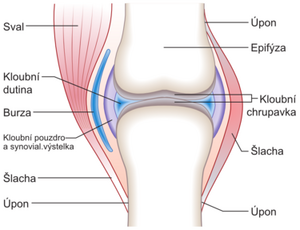Tumors of the joints
These tumors often arise both directly from the joints and from the surrounding structures. In the first case, we distinguish between synovial osteochondromatosis, villonodular pigmented synovitis and synovial sarcoma. A hemangioma, lipoma, fibroma or neurofibroma can arise from the surrounding structures.
Synovial osteochondromatosis[edit | edit source]
It is a benign finding of multiple intrasynoval chondromas that can ossify from the center of the deposit. They appear as oval deposits in the synovial membrane, causing a nodular overgrown joint surface. The tumor is sharply demarcated, rarely it can become malignant in chondrosarcoma. It causes movement disorders, the so-called joint mice resulting from the tearing of the synovial membrane with cartilaginous nodes.
Vilonodular pigmented synovitis[edit | edit source]
It is a diffuse giant cell tumor in the synovial lining of tendon sheaths, completely benign. It arises from the thickening of the synovial membrane, which is villous and nodularly excessive on the surface. Brown pigmentation by hemosiderin is typical. The treatment is carried out by extirpation of the tumor, which prevents the destruction of the joint. Histologically, we find increased synovialocytes A and B.
Synovial sarcoma (malignant synovialioma)[edit | edit source]
It is a high-grade malignant tumor of young adulthood, also known as soft tissue carcinosarcoma (according to the expression of epithelioid features). It can occur anywhere, most often in the vicinity of large joints (typically the knee), which is how it got its name, but it does not originate from synovial cells and has nothing to do with the joint apart from its location. The essence of the origin is translocation with the formation of a fusion transcript.
We distinguish:
- monophasic - gelatinous, fleshy, less differentiated; if it is made up of only spindle cells, it is called monophasic spindle cell, and if it is made up of only glandular cells, then it is a glandular sarcoma
- biphasic - formed by spindle-shaped and glandular mucus-forming cells, similar to endometrial cells
The tumor often recurs and metastasizes to the lungs. Therapy is difficult - resection is necessary; responds poorly to chemotherapy and radiotherapy.
Links[edit | edit source]
Related articles[edit | edit source]
Used literature[edit | edit source]
- POVÝŠIL, Ctibor – ŠTEINER, Ivo – DUŠEK, Pavel, et al. Speciální patologie : Basisübungen für alle Sportarten. 2. edition. Praha : Galén, 2007. 430 pp. ISBN 978-807262-494-2.
Categories: Pathology, Orthopedics, Oncology

